heater FORD RANGER 2010 2.G Owners Manual
[x] Cancel search | Manufacturer: FORD, Model Year: 2010, Model line: RANGER, Model: FORD RANGER 2010 2.GPages: 286, PDF Size: 2.57 MB
Page 1 of 286
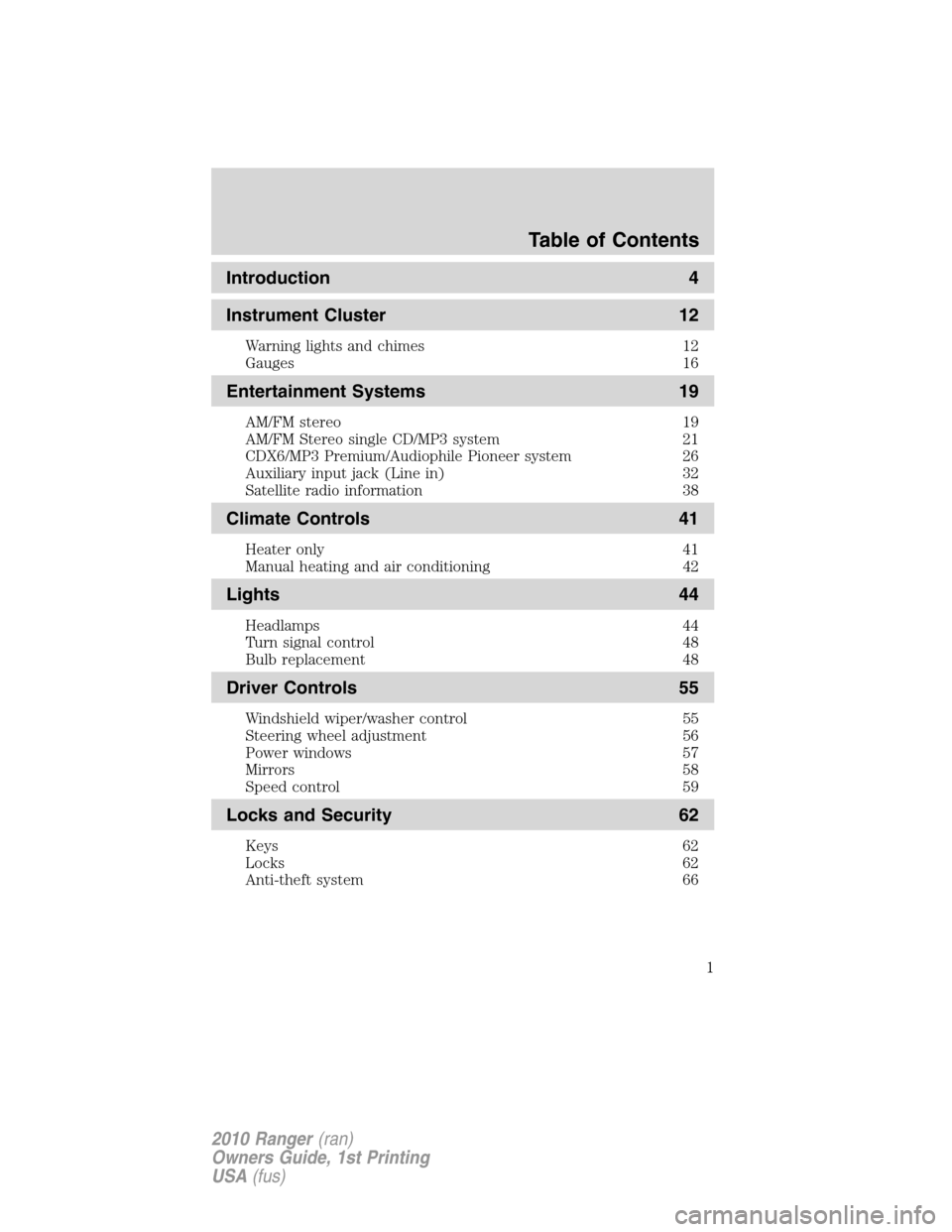
Introduction 4
Instrument Cluster 12
Warning lights and chimes 12
Gauges 16
Entertainment Systems 19
AM/FM stereo 19
AM/FM Stereo single CD/MP3 system 21
CDX6/MP3 Premium/Audiophile Pioneer system 26
Auxiliary input jack (Line in) 32
Satellite radio information 38
Climate Controls 41
Heater only 41
Manual heating and air conditioning 42
Lights 44
Headlamps 44
Turn signal control 48
Bulb replacement 48
Driver Controls 55
Windshield wiper/washer control 55
Steering wheel adjustment 56
Power windows 57
Mirrors 58
Speed control 59
Locks and Security 62
Keys 62
Locks 62
Anti-theft system 66
Table of Contents
1
2010 Ranger(ran)
Owners Guide, 1st Printing
USA(fus)
Page 41 of 286
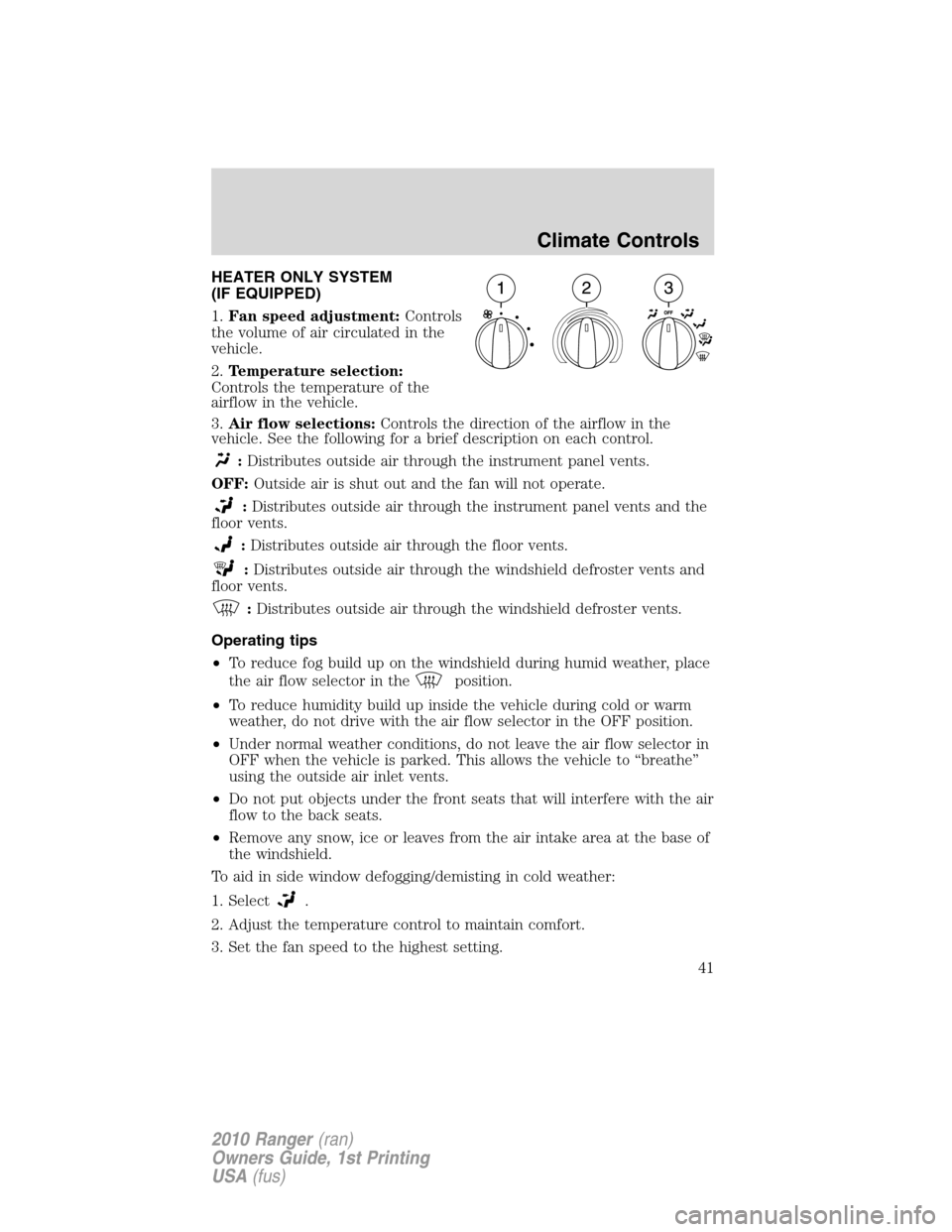
HEATER ONLY SYSTEM
(IF EQUIPPED)
1.Fan speed adjustment:Controls
the volume of air circulated in the
vehicle.
2.Temperature selection:
Controls the temperature of the
airflow in the vehicle.
3.Air flow selections:Controls the direction of the airflow in the
vehicle. See the following for a brief description on each control.
:Distributes outside air through the instrument panel vents.
OFF:Outside air is shut out and the fan will not operate.
:Distributes outside air through the instrument panel vents and the
floor vents.
:Distributes outside air through the floor vents.
:Distributes outside air through the windshield defroster vents and
floor vents.
:Distributes outside air through the windshield defroster vents.
Operating tips
•To reduce fog build up on the windshield during humid weather, place
the air flow selector in the
position.
•To reduce humidity build up inside the vehicle during cold or warm
weather, do not drive with the air flow selector in the OFF position.
•Under normal weather conditions, do not leave the air flow selector in
OFF when the vehicle is parked. This allows the vehicle to “breathe”
using the outside air inlet vents.
•Do not put objects under the front seats that will interfere with the air
flow to the back seats.
•Remove any snow, ice or leaves from the air intake area at the base of
the windshield.
To aid in side window defogging/demisting in cold weather:
1. Select
.
2. Adjust the temperature control to maintain comfort.
3. Set the fan speed to the highest setting.
Climate Controls
41
2010 Ranger(ran)
Owners Guide, 1st Printing
USA(fus)
Page 162 of 286
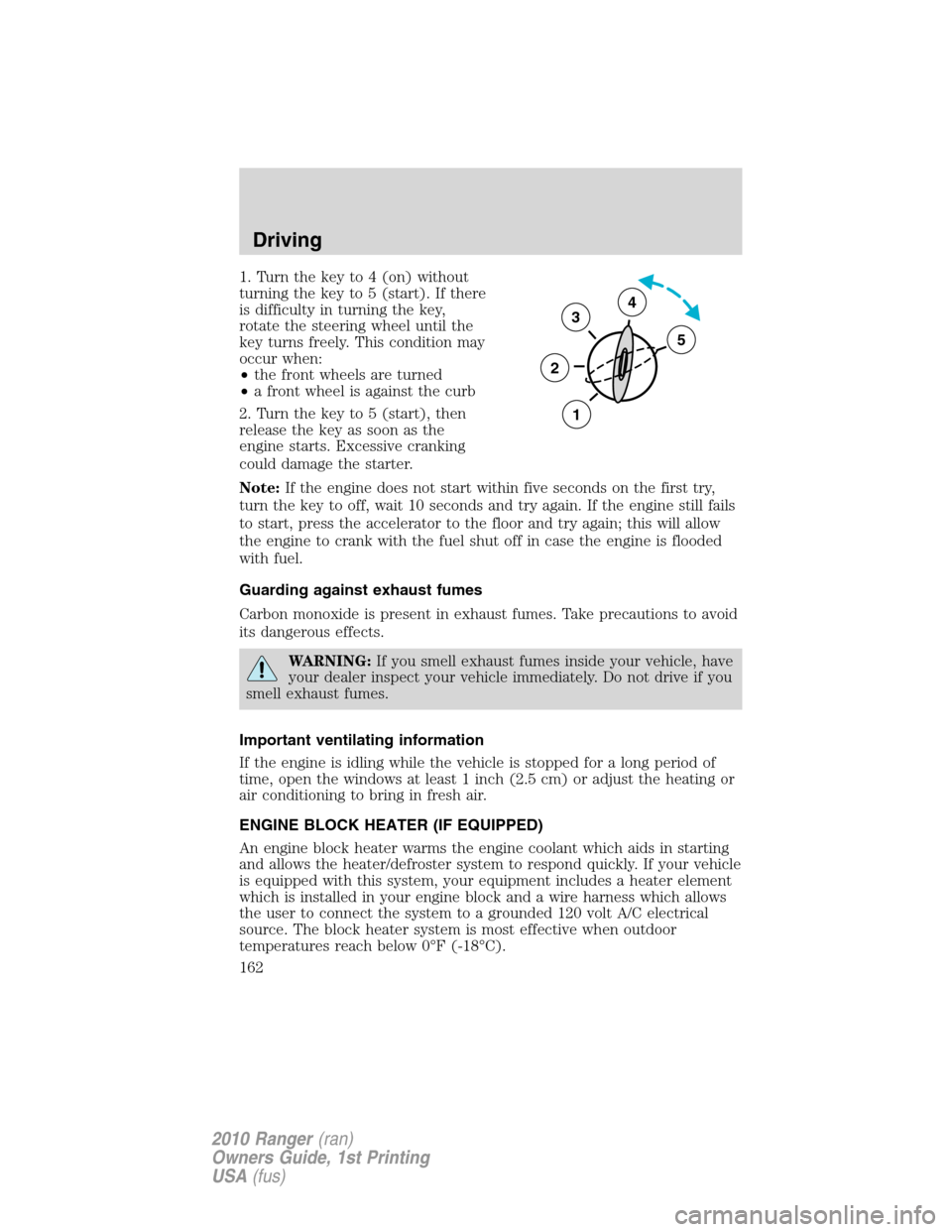
1. Turn the key to 4 (on) without
turning the key to 5 (start). If there
is difficulty in turning the key,
rotate the steering wheel until the
key turns freely. This condition may
occur when:
•the front wheels are turned
•a front wheel is against the curb
2. Turn the key to 5 (start), then
release the key as soon as the
engine starts. Excessive cranking
could damage the starter.
Note:If the engine does not start within five seconds on the first try,
turn the key to off, wait 10 seconds and try again. If the engine still fails
to start, press the accelerator to the floor and try again; this will allow
the engine to crank with the fuel shut off in case the engine is flooded
with fuel.
Guarding against exhaust fumes
Carbon monoxide is present in exhaust fumes. Take precautions to avoid
its dangerous effects.
WARNING:If you smell exhaust fumes inside your vehicle, have
your dealer inspect your vehicle immediately. Do not drive if you
smell exhaust fumes.
Important ventilating information
If the engine is idling while the vehicle is stopped for a long period of
time, open the windows at least 1 inch (2.5 cm) or adjust the heating or
air conditioning to bring in fresh air.
ENGINE BLOCK HEATER (IF EQUIPPED)
An engine block heater warms the engine coolant which aids in starting
and allows the heater/defroster system to respond quickly. If your vehicle
is equipped with this system, your equipment includes a heater element
which is installed in your engine block and a wire harness which allows
the user to connect the system to a grounded 120 volt A/C electrical
source. The block heater system is most effective when outdoor
temperatures reach below 0°F (-18°C).
3
2
1
5
4
Driving
162
2010 Ranger(ran)
Owners Guide, 1st Printing
USA(fus)
Page 163 of 286
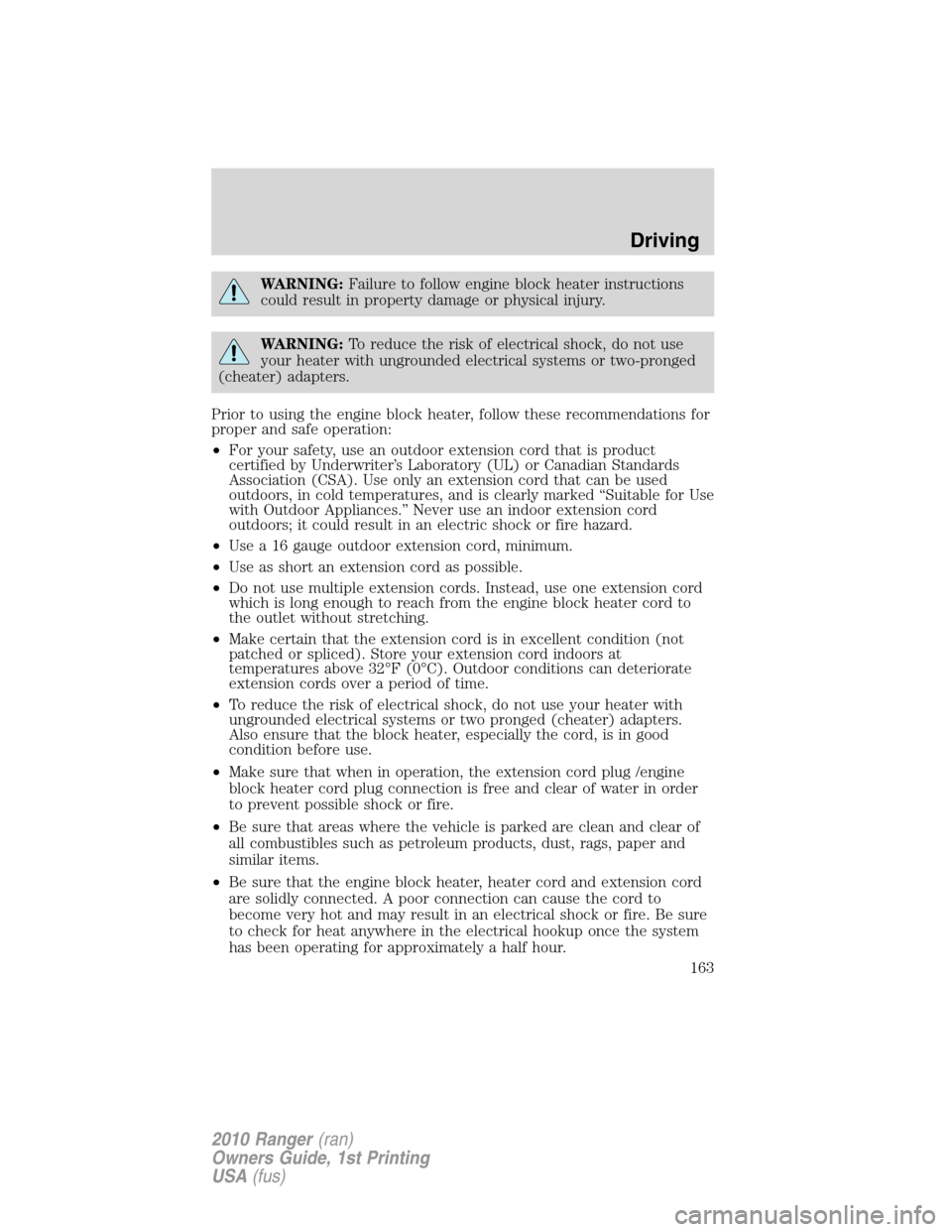
WARNING:Failure to follow engine block heater instructions
could result in property damage or physical injury.
WARNING:To reduce the risk of electrical shock, do not use
your heater with ungrounded electrical systems or two-pronged
(cheater) adapters.
Prior to using the engine block heater, follow these recommendations for
proper and safe operation:
•For your safety, use an outdoor extension cord that is product
certified by Underwriter’s Laboratory (UL) or Canadian Standards
Association (CSA). Use only an extension cord that can be used
outdoors, in cold temperatures, and is clearly marked “Suitable for Use
with Outdoor Appliances.” Never use an indoor extension cord
outdoors; it could result in an electric shock or fire hazard.
•Use a 16 gauge outdoor extension cord, minimum.
•Use as short an extension cord as possible.
•Do not use multiple extension cords. Instead, use one extension cord
which is long enough to reach from the engine block heater cord to
the outlet without stretching.
•Make certain that the extension cord is in excellent condition (not
patched or spliced). Store your extension cord indoors at
temperatures above 32°F (0°C). Outdoor conditions can deteriorate
extension cords over a period of time.
•To reduce the risk of electrical shock, do not use your heater with
ungrounded electrical systems or two pronged (cheater) adapters.
Also ensure that the block heater, especially the cord, is in good
condition before use.
•Make sure that when in operation, the extension cord plug /engine
block heater cord plug connection is free and clear of water in order
to prevent possible shock or fire.
•Be sure that areas where the vehicle is parked are clean and clear of
all combustibles such as petroleum products, dust, rags, paper and
similar items.
•Be sure that the engine block heater, heater cord and extension cord
are solidly connected. A poor connection can cause the cord to
become very hot and may result in an electrical shock or fire. Be sure
to check for heat anywhere in the electrical hookup once the system
has been operating for approximately a half hour.
Driving
163
2010 Ranger(ran)
Owners Guide, 1st Printing
USA(fus)
Page 164 of 286
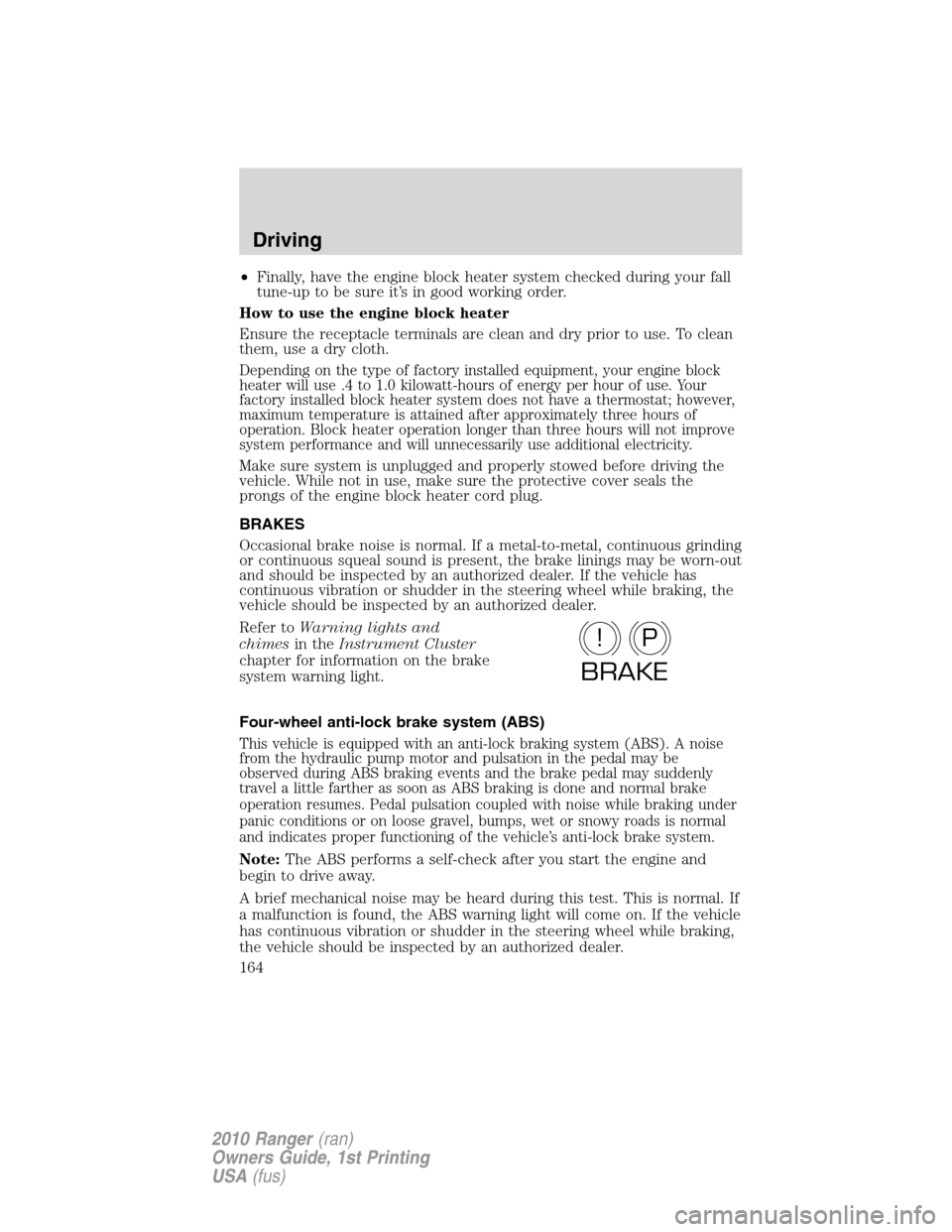
•Finally, have the engine block heater system checked during your fall
tune-up to be sure it’s in good working order.
How to use the engine block heater
Ensure the receptacle terminals are clean and dry prior to use. To clean
them, use a dry cloth.
Depending on the type of factory installed equipment, your engine block
heater will use .4 to 1.0 kilowatt-hours of energy per hour of use. Your
factory installed block heater system does not have a thermostat; however,
maximum temperature is attained after approximately three hours of
operation. Block heater operation longer than three hours will not improve
system performance and will unnecessarily use additional electricity.
Make sure system is unplugged and properly stowed before driving the
vehicle. While not in use, make sure the protective cover seals the
prongs of the engine block heater cord plug.
BRAKES
Occasional brake noise is normal. If a metal-to-metal, continuous grinding
or continuous squeal sound is present, the brake linings may be worn-out
and should be inspected by an authorized dealer. If the vehicle has
continuous vibration or shudder in the steering wheel while braking, the
vehicle should be inspected by an authorized dealer.
Refer toWarning lights and
chimesin theInstrument Cluster
chapter for information on the brake
system warning light.
Four-wheel anti-lock brake system (ABS)
This vehicle is equipped with an anti-lock braking system (ABS). A noise
from the hydraulic pump motor and pulsation in the pedal may be
observed during ABS braking events and the brake pedal may suddenly
travel a little farther as soon as ABS braking is done and normal brake
operation resumes. Pedal pulsation coupled with noise while braking under
panic conditions or on loose gravel, bumps, wet or snowy roads is normal
and indicates proper functioning of the vehicle’s anti-lock brake system.
Note:The ABS performs a self-check after you start the engine and
begin to drive away.
A brief mechanical noise may be heard during this test. This is normal. If
a malfunction is found, the ABS warning light will come on. If the vehicle
has continuous vibration or shudder in the steering wheel while braking,
the vehicle should be inspected by an authorized dealer.
P!
BRAKE
Driving
164
2010 Ranger(ran)
Owners Guide, 1st Printing
USA(fus)
Page 211 of 286
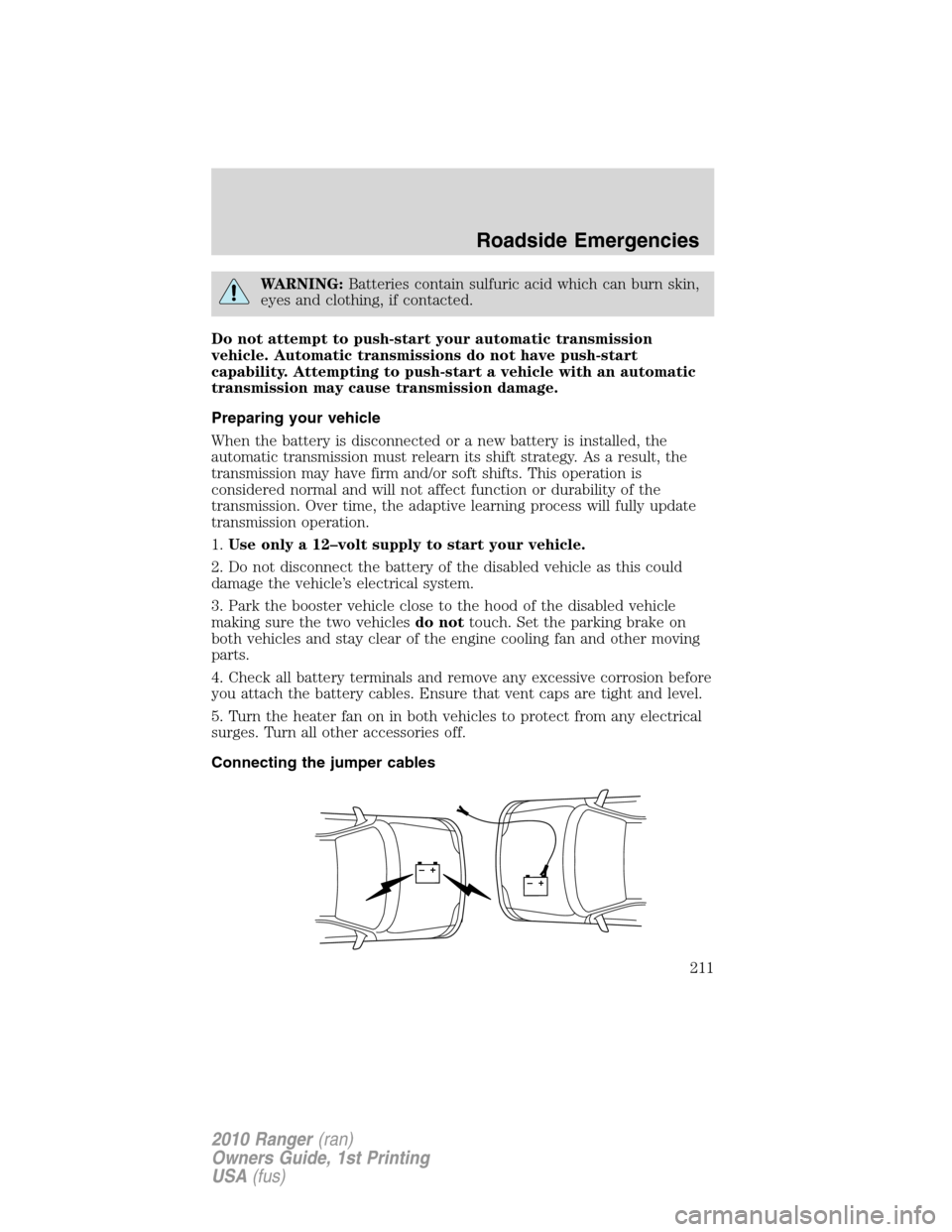
WARNING:Batteries contain sulfuric acid which can burn skin,
eyes and clothing, if contacted.
Do not attempt to push-start your automatic transmission
vehicle. Automatic transmissions do not have push-start
capability. Attempting to push-start a vehicle with an automatic
transmission may cause transmission damage.
Preparing your vehicle
When the battery is disconnected or a new battery is installed, the
automatic transmission must relearn its shift strategy. As a result, the
transmission may have firm and/or soft shifts. This operation is
considered normal and will not affect function or durability of the
transmission. Over time, the adaptive learning process will fully update
transmission operation.
1.Use only a 12–volt supply to start your vehicle.
2. Do not disconnect the battery of the disabled vehicle as this could
damage the vehicle’s electrical system.
3. Park the booster vehicle close to the hood of the disabled vehicle
making sure the two vehiclesdo nottouch. Set the parking brake on
both vehicles and stay clear of the engine cooling fan and other moving
parts.
4. Check all battery terminals and remove any excessive corrosion before
you attach the battery cables. Ensure that vent caps are tight and level.
5. Turn the heater fan on in both vehicles to protect from any electrical
surges. Turn all other accessories off.
Connecting the jumper cables
+–+–
Roadside Emergencies
211
2010 Ranger(ran)
Owners Guide, 1st Printing
USA(fus)
Page 282 of 286
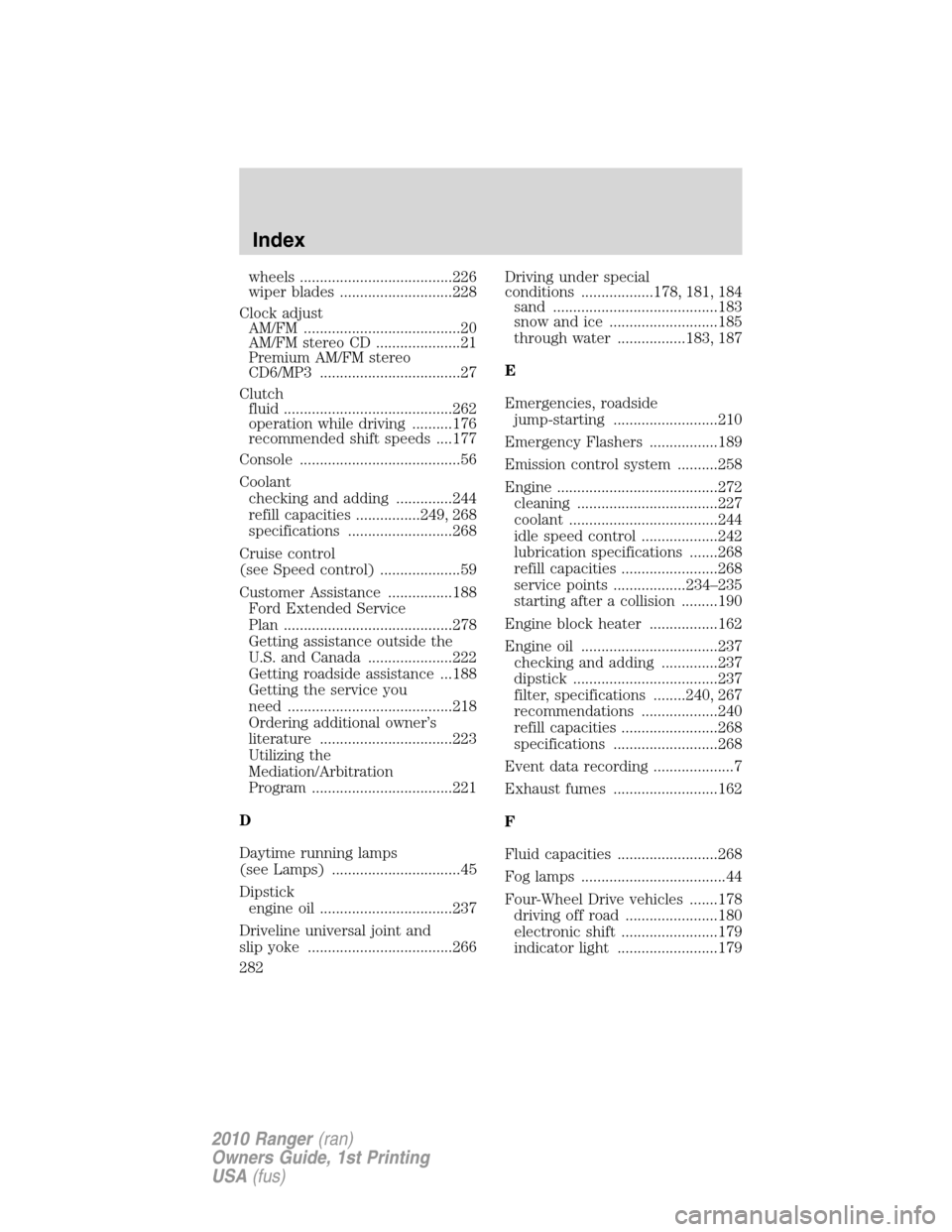
wheels ......................................226
wiper blades ............................228
Clock adjust
AM/FM .......................................20
AM/FM stereo CD .....................21
Premium AM/FM stereo
CD6/MP3 ...................................27
Clutch
fluid ..........................................262
operation while driving ..........176
recommended shift speeds ....177
Console ........................................56
Coolant
checking and adding ..............244
refill capacities ................249, 268
specifications ..........................268
Cruise control
(see Speed control) ....................59
Customer Assistance ................188
Ford Extended Service
Plan ..........................................278
Getting assistance outside the
U.S. and Canada .....................222
Getting roadside assistance ...188
Getting the service you
need .........................................218
Ordering additional owner’s
literature .................................223
Utilizing the
Mediation/Arbitration
Program ...................................221
D
Daytime running lamps
(see Lamps) ................................45
Dipstick
engine oil .................................237
Driveline universal joint and
slip yoke ....................................266Driving under special
conditions ..................178, 181, 184
sand .........................................183
snow and ice ...........................185
through water .................183, 187
E
Emergencies, roadside
jump-starting ..........................210
Emergency Flashers .................189
Emission control system ..........258
Engine ........................................272
cleaning ...................................227
coolant .....................................244
idle speed control ...................242
lubrication specifications .......268
refill capacities ........................268
service points ..................234–235
starting after a collision .........190
Engine block heater .................162
Engine oil ..................................237
checking and adding ..............237
dipstick ....................................237
filter, specifications ........240, 267
recommendations ...................240
refill capacities ........................268
specifications ..........................268
Event data recording ....................7
Exhaust fumes ..........................162
F
Fluid capacities .........................268
Fog lamps ....................................44
Four-Wheel Drive vehicles .......178
driving off road .......................180
electronic shift ........................179
indicator light .........................179
Index
282
2010 Ranger(ran)
Owners Guide, 1st Printing
USA(fus)